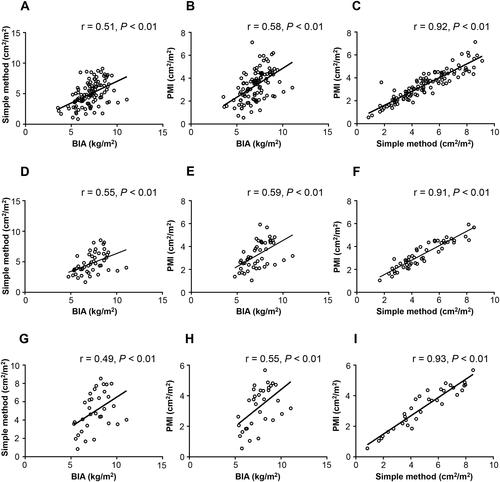Sarcopenia is associated with poor prognosis in patients with chronic liver disease (CLD). As rapid skeletal muscle wasting predicts worse prognosis and a novel therapy for sarcopenia needs to be evaluated for validation, accurate evaluation methods for relative changes in muscle mass are crucial.
We screened CLD patients who had skeletal muscle mass evaluation between June 2015 and December 2017. Patients were included if they had adequate information, were followed for >6 months, and had skeletal muscle mass evaluation by both bioelectrical impedance analysis (BIA) and computed tomography (CT) imaging at baseline and the second evaluation point. We compared BIA and CT imaging in terms of their ability to quantify skeletal muscle mass and identify relative changes in muscle mass in CLD patients.
Of the screened 447 CLD patients, 110 were included in this study, and 71 (64.5%) were men. The median age was 68 (range 21 to 90) years. In total, 83 (75.5%) and 32 (29.1%) patients had liver cirrhosis and hepatocellular carcinoma, respectively. Of them, 50 (45.5%) patients were liver cirrhosis patients without hepatocellular carcinoma through the observation period. Skeletal muscle mass index (SMI) by BIA, psoas muscle mass index (PMI), and SMI based on CT imaging were significantly correlated at baseline [SMI by simple CT method and SMI by BIA (r = 0.61, P < 0.01), SMI by BIA and PMI (r = 0.65, P < 0.01), and SMI by simple CT method and PMI (r = 0.82, P < 0.01), respectively] and second evaluation point [SMI by simple CT method and SMI by BIA (r = 0.51, P < 0.01), SMI by BIA and PMI (r = 0.58, P < 0.01), and SMI by simple CT method and PMI (r = 0.92, P < 0.01), respectively]. Similar to previous reports, based on the PMI and SMI by simple CT method, patients with more severe liver dysfunction experienced more rapid skeletal muscle mass loss (ΔSimple method/years and ΔPMI/years in patients with Child‑Pugh Classes A, B, and C: Child‑Pugh A, −3.34%; B, −11.77%; C, −18.78%; and Child‑Pugh A, −0.78%; B, −6.33%; C, −7.71%, respectively). Completely opposite results were obtained based on SMI by BIA (Child‑Pugh A, −0.70%; B, 1.42%; C, 12.48%). A subgroup analysis revealed that in patients with fluid retention and diuretic administration, SMI by BIA increased with time (P < 0.01).
For accurate evaluation of the relative changes in skeletal muscle mass in patients with CLD, CT imaging method, and not BIA, is one of the proper methods.


